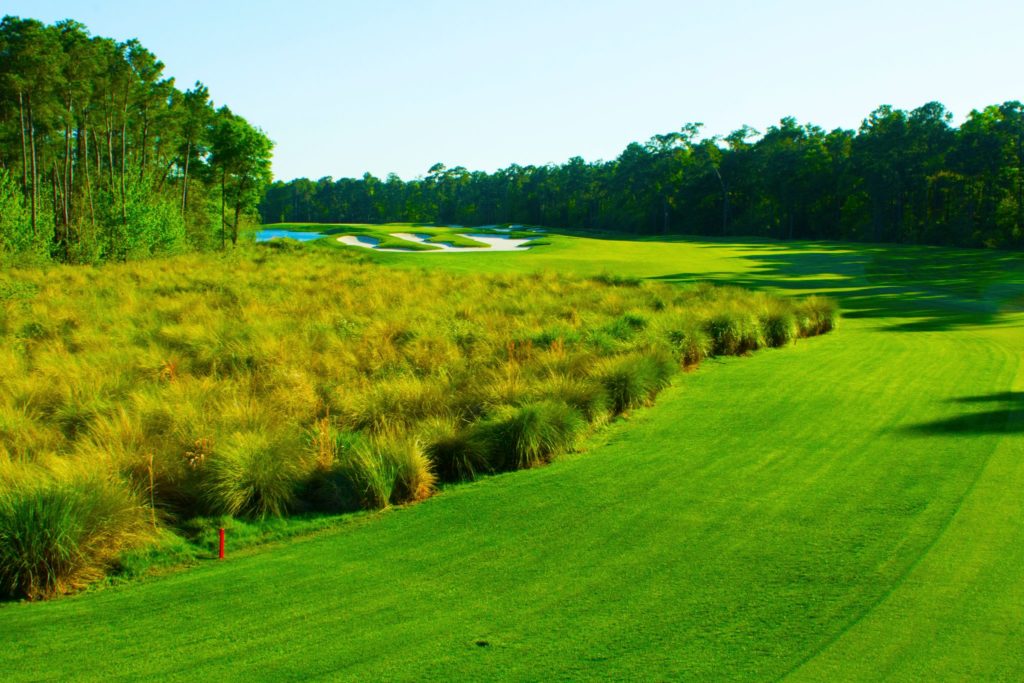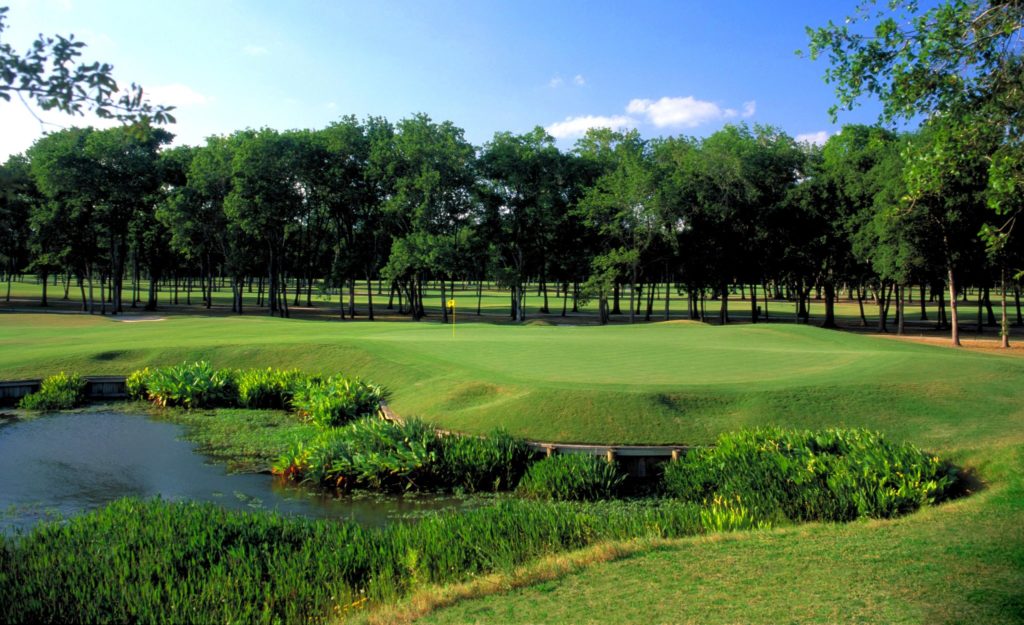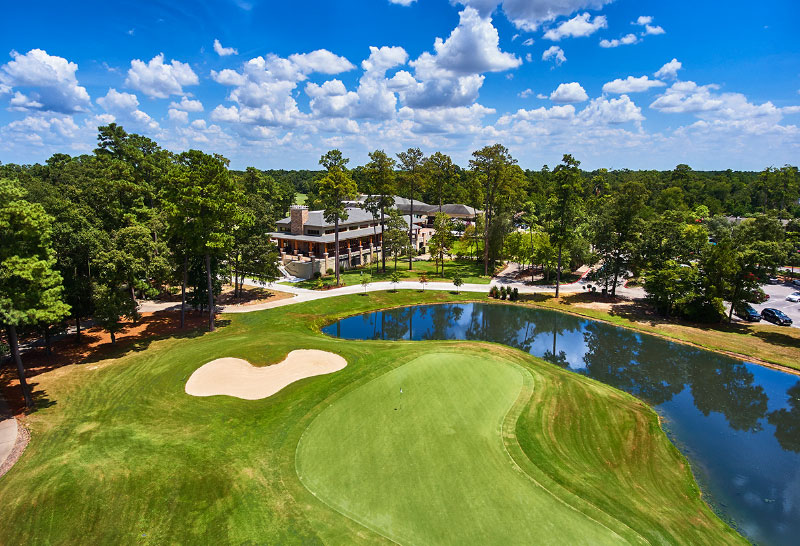
Woodlands
The city of Houston and its surrounding communities comprise the fifth largest metropolitan area in the United States, just behind its Texas cousin to the north – Dallas-Fort Worth – and ahead of Washington D.C.
Houston and its suburbs have grown by more than 20 percent in the past decade, more than any other of the top-20 metro areas in the country.
Along with all the hustle and bustle and growth and great baseball (I’m talking about those Astros), Houston is a real golf city – and real destination for the grand game.
There are a handful of splendid resorts (two of which will be featured below) and scores of great public courses. The latter category is represented well by Memorial Park Golf Course, the home of the venerable Houston Open on the PGA Tour’s Fall Swing, as well as the pair of facilities detailed here.
The Bayou City is a fine all-seasons destination for golf, with more than 200 days of sunshine (some of it searing) but the fall and early spring are likely the best time to play golf here – since that’s when the area’s humidity is at its most tolerable.
The two courses at The Woodlands Resort, 45 minutes north of the city; the loud and proud Margaritaville Resort on Lake Conroe and its fine track; the familiar public face of the Golf Club of Houston in Humble; and the pair of top-ranked courses at the BlackHorse Golf Club in Cypress just scratch the surface of great golf in the area – but these stops can be a great beginning to a visit where golf is top on the agenda.

Margaritaville Resort on Lake Conroe

Golf Club of Houston
The Golf Club of Houston is all that and more
From the tee shot on the 395-yard first hole to the final putt on the immense green at the 487-yard 18th, the Tournament course at the Golf Course of Houston in Humble is all about space and how you make the most of it.
The par-72, 7,425-yard layout designed by Rees Jones is an oversized Texas masterpiece, just the kind of track you’d expect to see host a PGA Tour event — and it did for 14 consecutive years ending in 2019.
Located 16 miles from downtown and five miles from George Bush Intercontinental Airport, the Golf Club of Houston occupies more than 376 acres of wooded terrain surrounded by wetlands, lakes and native wildlife. The Tournament course — the younger brother of the adjacent Member course — has been open since 2005.
Jones believes the daily-fee Tournament course’s natural space is what most overwhelms players, from those on Tour to everyday golfers. “The course has a wonderful flow to it,” he said. “It has beautiful, old-fashioned bunkers, carved like those on courses built in the Depression Era. But the Tournament course was built for today’s golfers, giving players chances to make birdies on several holes and forcing them to work to make pars on others.”
Jones brought in former PGA Tour player David Toms to consult on the design, and the Louisianan provided a lot of access and input. “I think the course is challenging, but fair,” Toms said. “There is a good variety of par-4s, par-5s and, particularly, par-3s, so that not one type of player has an advantage.”
The feeling of isolation is wonderful as its fairways and sight-corridors are free from any housing, leaving players with a feeling of being away from the loud city life that is actually just around the bend.
Greens Bayou winds through the routing to serve as a water hazard; nine holes involve water that encroaches close to putting surfaces. Because of low-mown green surrounds, balls can roll off the greens and end up wet.
With five par-4s stretching 440 yards or more, it would be easy to say the course favors big hitters. Not quite, as the track challenges all elements of the game thanks to a pleasing mix of short holes, dramatic par-3s and a sense of fairness throughout.
One of the more interesting holes on the Tournament course is its shortest par-4, the 335-yard 12th. With water down the entire right side, longer hitters may be tempted to take a shot at the green; shorter hitters also have a chance as one of the tees is only 238 yards.
The last four holes are a gauntlet. The 609-yard par-5 15th has wetlands right and a creek that crosses the fairway in the landing area and is anything but a routine three-shotter. The 16th is a 200-yard par-3 with splendid bunkering and a green at a diagonal, with the back-right pin placement particularly demanding.
It’s time to bring out the big stick for the two final holes. The 487-yard par-4 17th has a creek about 300 yards off the tee and fairway bunkers along the right. Adding to the task is that this hole usually plays into the wind.
The par-4, 484-yard finisher is a real knee-knocker, even for touring pros. A lake runs along the entire left side and the approach leaves little margin for error, with water left and a huge bunker right. If you ever watched the Houston Open when it was played here, you know how tough that hole was for the best golfers in the world.
There is little doubt that some of the holes on the Tournament course play long, but expect to pick up some yardage if you can find the speed slots in fairways to get more run.
The Golf Club of Houston has a state-of-the-art practice range with a 100,000-square-foot double-ended teeing area, seven target-greens ranging from 100-300 yards, and an extensive short game practice area. A 33,000-square-foot clubhouse features two pro shops (one members-only), dining areas and a bar, spacious locker rooms, and an outdoor terrace with views of the course.
When I go to Houston, the Golf Club of Houston’s Tournament course is always on my must-play list and it should be on yours too.

Golf Club of Houston
Wasting away again in Margaritaville’s golf course
About an hour north of downtown Houston, the southern banks of sprawling Lake Conroe is a great place to get away, even more so with the opening of the Margaritaville Lake Resort in June 2020. This is a place where you can have loads of fun both on and off the golf course.
Set on 186 waterfront acres on the shores of the huge lake, Margaritaville brings an entirely unique lodging concept to the destination, providing guests authentic fun and escapism in a “no worries” atmosphere.
This resort used to be called La Torretta (and Del Lago before that). It’s the home of a 6,921-yard, tree-lined course renovated in 2007 by golf architect Jeff Blume. Blume’s refashioned track sits off the lake but is still buffeted by winds off the 21,000-acre body of water.
Though the track occupies the footprint of a course designed in the late 1970s by Dave Marr and Jay Riviere, Blume took the pine-lined routing and recreated a course that is challenging and fun. It will yield birdies to players who can execute shots, find the right spots via approaches to the massive greens, and roll their ball when they get there.
Among Blume’s improvements were adding 150 yards to the course, reversing the nines to their original rotation, and repositioning a handful of greens. He also improved the visual aesthetics and maintainability, while changing the once-punitive par-4 ninth into a risk-reward par-5.
Margaritaville’s course now plays to a par 71, with three progressively tougher par-3s on the back-nine. Blume liked the layout’s mature trees and well-defined corridors but sought to return shot values. He did so by positioning bunkers in the fairways to pinch the landing areas, while daring players to hit over them to optimize scoring chances.
Doglegs move left and right as fairway mounds and grass hollows can bounce and grab drives and run-up approaches. Pine straw in roughs adds borders to the course and provides a stark contrast to the lush fairways. Its fairways are tight and gently rolling with some contour and tilt, and there’s enough water – though not Lake Conroe – to require focus.
The back nine here is more scenic and not quite as tight. It has three fun but difficult par 3s as well as the fantastic 446-yard par-4 15th – the course’s signature hole – thanks to its cascading waterfall. On this half of the course, players will be faced with more forced carries and several elevated greens and tees.
The 448-yard, dogleg-right, par-4 10th is one of the hardest holes here as it’s long and well-guarded by bunkers along the fairway and around the green. The 536-yard, par-5 18th is a memorable finisher: a downhill dogleg-right involving a risk-reward tee shot and a difficult approach to a raised green with a huge bunker and water along the right.
The golf course at Margaritaville Lake Conroe is like the resort itself: a fine place for get away and to stay awhile.
Amenities include five signature Margaritaville-inspired restaurants and bars anchored by LandShark Bar & Grill, with panoramic views of the lake. The three-acre Jolly Mon Water Park features a lazy river, pools for all ages, waterslides, a splash zone, and a year-round heated pool.
Choices make BlackHorse Golf Club one of Houston’s best
Golfers love to be tested, and when course designers offer a handful of choices for players to consider, that sense of challenge is always ratcheted up a few notches. BlackHorse Golf Club is all about decisions, thanks to a pair of demanding 18-hole courses routed over, across and through varying landscapes that make the player think before every shot.
Located in the north Houston suburb of Cypress in the BlackHorse Ranch community and fashioned by the duo of Peter Jacobsen and Jim Hardy, BlackHorse’s two courses – called North and South – opened for play in 2000. The courses have been rated as the No. 1 Daily Fee Facility in Houston, and they are both really good.
BlackHorse GC’s courses are traditional in style, thanks to a plethora of mature trees – majestic oaks, live oaks and pine – that lend the tracks an aged feel. The courses’ rolling landscape is rarely found in the flatlands around the nation’s fourth-largest city, which make them both testing and beautiful.
And thanks to teeing grounds that offers six locations to accommodate golfers of all levels, BlackHorse can be fun without being intimidating. “These courses offer every golfer the opportunity to play a challenging yet fair round of golf,” Jacobsen said. “The details, layout and environmental use of the land make this a truly special place.”
Around the layouts are wetlands, oxbows, palmetto and huge oaks that attract ducks, egrets and sandhill cranes. “We designed these courses to use the natural terrain and features of the area,” Hardy said. “The use of the creek, lakes and wetlands, as well as the sand quarry (on the South Course), and magnificent trees combine to render this course unique among daily-fee courses.”
The North Course is the tougher of the two tracks, but can also be more forgiving for long hitters who can scramble. Playing at a par of 72 and at 7,301 yards from its “Big Jake” tees, North offers ample places to bang the driver.
The 179-yard, par-3 sixth is North’s signature hole. Playing as much as two clubs more if the wind in your face (it usually is), the tee shot must clear an old oxbow with native palmetto growing in the creek bottom. The green is fortified with railroad ties and three bunkers surround the left side of a severely sloping green that tips rightward toward the hazard. Being on the correct side of the slope is a key to avoiding difficult putts.
Beginning at the 425-yard par-4 ninth, North gets much tougher, mostly because of a series of taxing two-shotters. Every par-4 on the back-nine stretches at least 436 yards, and three of them, the 457-yard 10th, the 441-yard 12th, and the difficult 462-yard 15th, will test your long-iron game.
The South Course at BlackHorse features varied environs, tight corridors lined by elm, ash and oak sculpted around large lakes to a fabulous finishing stretch. The final six holes play through an expansive sand quarry transformed into a colorful array of wetlands.
Jacobsen and Hardy love long and demanding par 4s and South delivers those nearly as well as its sister track. On the front nine alone three of the five two-shotters extend more than 444 yards and, because South requires more accuracy, these may be tougher than the holes of like distance on North.
But the South’s front side also sports two par 5s, the 514-yard fifth and the 518-yard ninth, that can be attacked in two, making up for some of the struggle on its par 4s.
At 368 yards, the 16th is a drivable par-4 if played down the left side. The tee shot must carry the wetlands in front that skirt the left of the fairway, however, and there’s a run-up area over the trouble in front of the green that allows you to land short of the putting surface.
No. 17 is perhaps the best par-3 on South, carded at 199 yards and surrounded by wetlands, with a winding water-level bridge about 100 yards long up to the elevated green. It is one of BlackHorse’s most scenic holes, but don’t get too caught up in the view as precision counts here.
South concludes with a 515-yard par-5 that is, again, reachable in two. The approach must traverse a deep ditch, and the green runs away on the left and rear, so play wisely.
South (which plays at 7,191 yards) is a fun track with a little bit of everything, including real birdie chances on its finishing holes.

BlackHorse Golf Club
The Woodlands Resort’s two courses are different sides of the same coin
There is a certain sense of style at the Woodlands Resort, set in the city of the same name about 35 minutes north of downtown. Stretching across 350 lush acres, this is an all-encompassing Texas escape within easy reach where play and productivity come naturally. The resort rests amidst the woods and waterways surrounding its Forest Oasis waterpark, plush hotel, expansive conference center and its two golf courses, the Oaks and Panther Trail.
The Oaks course was designed by Joe Lee and Robert von Hagge in 1975 and redesigned in 1999. It’s easy to see how the course got its name as you walk to the first tee, which is draped by towering oaks, some of which are covered with gray moss.
You’ll find excellent conditions throughout, with water coming into play on 10 holes, large undulating putting surfaces, and generous fairways lined with oaks among beautiful homes protected with generous setbacks.
The Oaks course is carded at 7,051 yards and plays to a par of 72 and is a very traditional 18 holes of golf – there are no trick shots here. It’s challenging but fair, and a relatively straightforward layout that is a real joy to play. The fairways are generous but the rough is thick and if you miss the tall grass you’re either under trees or lost in a dense forest. If you don’t bite off more than you can chew you’ll can find ways to score.
The Oaks was built with a prevailing southeasterly breeze in mind, and even on calm days, it is no pushover. Bunkers and water features have been placed so that they loom large down the fairways and around the greens. The hazards get into your head, but cool nerves and confident swings can deposit shots where they belong.
The Oaks’ short holes, its foursome of par 3s, each offer a different look and challenge. “There’s not a pushover in the bunch,” Case said.
The par-5 No. 7 has the potential to be a round-breaker as temptation abounds, but risk is great. Ditto the 16th, at 581 yards the longest on the course and a place where almost any number is possible.
Panther Trail – like the cat it’s named after – is a sleek course with innovative contours, stunning water features, and lush fairways framed with native grasses and more than 20 acres of Texas wildflowers. It was originally designed by Joe Lee and von Hagge and completely renovated in 2002 by Roy Case, who – at the time – was the design consultant for the Arnold Palmer Management Company.
Case’s courses are known for their physical beauty, visual interest, and quality of play and he hits all the right notes at Panther Trail, which plays at 7,008 yards.
Panther Trail’s greens can be demanding; most are of average size, but some are turtle-backed and a majority have some slope and contour and all are bordered with bunkers.
The back nine is outstanding as every hole is unique and different. The holes here throw a little bit of everything at you including doglegs, water, strategically placed bunkers, risk-reward opportunities, forced carries, mounds, and raised, guarded greens.
The closing hole will make you want to come back and play Panther Trail again – it’s a 413-yard par-4 that finishes at the edge of one of the hotel buildings with an island green protected by two large bunkers. It’s considered one of the best par 4s in Houston.
The Oaks plays a little longer, but Panther Trail plays about three strokes harder. Panther Trail has been ranked one of the Top 5 courses to play in the area and it’s deserving.

Woodlands: Panther Trail

